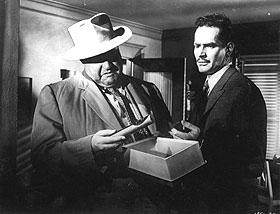Length of take

A still from Cinema Paradiso (1989)
If shot sizes tend to be large at the beginnings of films and scenes, an equivalent characteristic can be noted for shot duration of the length of a take. The average duration of a shot approximately 6 seconds, but introductory shots are often at least twice this length. Again, the pace tends to be slower in order to allow the viewer more time to become acquainted with characters and locations. If we look at 2 minutes from near the beginning of Cinema Paradiso (1989) we find only five shots. Within this time we are introduced to the main character Salvatore and his wife, who informs him that an old friend, Alfredo, has died. This leads into a flashback to his youth which goes on to provide his childhood memories, which constitute the bulk of the film. If we then look at a 2 minute period from the climactic section of the film, when Salvatore saves Alfredo from a fire in the village cinema, we find 52 shots. The narrative allows short takes because we know the location and characters well, and the narrative also requires short takes because the scene involves action and panic. Imagine the effect if we reversed the shot duration: 52 shots in 2 minutes to introduce characters and only five shots to cover 2 minutes of fast-moving action.
There can be other reasons for long takes in a film. Orson Welles famously and Jean Luc Goddard infamously, have used long takes. In Goddard’s Weekend (1968) one shot lasts 8 minutes and gradually reveals to us a long line of cars in a traffic jam. As well as also helping to ensure that the film is ‘alternative’, which was no doubt part of the director’s intention, the shot also helps make one of Goddard’s points about cultural life and consumerism in 1960s France-the point being that while the trend of going away for the weekend grew, it increasingly resulted in people spending the weekend in traffic jams
 Welles began Touch of Evil (1953) with a shot lasts over 3 minutes. It begins with a close up of a bomb being planted in a car. The camera then rises to give us a bird’s eye view of the situation, including the car driving off. The camera tracks to catch up with the car, then drops down to enable us to hear a banal conversation between a border guard, a woman and a man. This technique builds suspense as we are expecting an explosion, which soon follows and brings the shot to a close. Being the exception to the rule begs the question, why use a long takes instead of editing together several shots covering the same action? It could be argued that in this instance we are given anoverview of what is happening in adjacent locations simultaneously as a way of providing us with the bigger picture. However, if this is the intention, then why is the technique not used more frequently?
Welles began Touch of Evil (1953) with a shot lasts over 3 minutes. It begins with a close up of a bomb being planted in a car. The camera then rises to give us a bird’s eye view of the situation, including the car driving off. The camera tracks to catch up with the car, then drops down to enable us to hear a banal conversation between a border guard, a woman and a man. This technique builds suspense as we are expecting an explosion, which soon follows and brings the shot to a close. Being the exception to the rule begs the question, why use a long takes instead of editing together several shots covering the same action? It could be argued that in this instance we are given anoverview of what is happening in adjacent locations simultaneously as a way of providing us with the bigger picture. However, if this is the intention, then why is the technique not used more frequently? Alternatively it could be argued that such a shot was motivated more by style than by the requirements of the narrative, which is not necessarily undesirable. For now it is sufficient to note that it is a technically impressive shot with incredible complex timing which has certainly gained a place within the study of film.
Having suggested that the long take at the beginning of Touch of Evil may be more to do with style than with content. It would be wrong to assume that this is always the case.
Depth of Field
Another aspect of cinematography is the depth of field. Depending on shutter speed, aperture and the amount of light available; a camera can focus on just a small part of what is in the frame or on the whole scene. Focusing on only part of a frame is known a shallow focus and is often used as a device for encouraging the audience to concentrate on a particular part of the scene. Conversely, seeing everything in focus, from foreground to background, is known as deep field photography or deep focus.
No comments:
Post a Comment